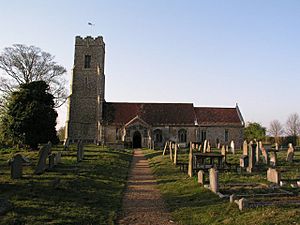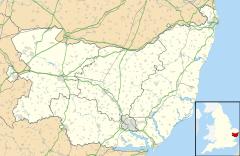Snape, Suffolk facts for kids
Quick facts for kids Snape |
|
|---|---|
 St John the Baptist, Snape |
|
| Population | 611 (2011) |
| Shire county | |
| Region | |
| Country | England |
| Sovereign state | United Kingdom |
| Post town | Saxmundham |
| Postcode district | IP17 |
| EU Parliament | East of England |
| UK Parliament |
|
Snape is a small village in the English county of Suffolk. It is located on the River Alde, not far from the town of Aldeburgh. In 2011, about 611 people lived there.
Snape is famous for its history, especially an Anglo-Saxon ship burial site. Today, it is best known for Snape Maltings. These old buildings were once used to make malt, but now they are a popular place for tourists. They also have a concert hall that hosts many events for the yearly Aldeburgh Festival.
Contents
Snape's Ancient Past
People have lived in Snape for around 2,000 years! The first village was on higher ground, near where the church is now. We don't know why the village moved closer to the river later on.
Roman Times in Snape
The Romans built a settlement here. They mainly focused on making salt, which was a very important product back then.
Anglo-Saxon Burials
During the Anglo-Saxon period, a powerful family called the Wuffingas ruled East Anglia. They used Snape as a special burial ground. Archaeologists have found amazing things here, including ship burials. These are graves where people were buried inside a ship, along with their treasures.
The Domesday Book and Snape Church
In 1085, a famous survey called the Domesday Book recorded that 49 men lived in Snape. It also mentioned a church with eight acres of land. This church was quite valuable for its time.
The church you see today was built in the 13th century. It originally had a thatched roof. Later, in the 15th century, a porch and a tower were added to it.
Snape Priory and Its Legacy
Snape Priory was a type of monastery founded in 1155. It was built by a local landowner named William Martell. He was about to leave for a big journey called the Third Crusade.
The priory lasted until 1525. Then, a powerful church leader named Thomas Wolsey closed it down and took its wealth. Today, only one barn built by the monks still stands. It was built way back in 1295.
The monks also built a watermill and probably the first bridge over the River Alde. This first bridge was made of wood. A brick bridge was built in 1802, and then a new one replaced it in 1960.
Snape's Main Businesses
Snape has had five main industries throughout its history.
Salt and Fertiliser Production
Under the Romans, Snape was known for making salt. Later, in the 19th century, another important industry was fertiliser. This fertiliser was made from a special rock called coprolite, which was found nearby.
A businessman from Saxmundham, Edward Packard, discovered how to make fertiliser from coprolite. This led to a period known as "the Suffolk Gold Rush" because many people made fortunes. Packard even started a company that became Fisons, which is now part of AstraZeneca.
Sugar Beet and Maltings
Sugar beet was also a key product grown in Snape. It was one of the first places in England to grow it for sale and export it to the Netherlands.
The Maltings, which produced high-quality malted barley, was another important industry. These buildings are now part of Snape's fifth main industry: tourism.
Snape as a Tourist Spot
Snape was a tourist destination even before the Maltings closed. In the 18th and 19th centuries, the Snape Race Course held horse races every year for nearly 150 years.
To make it easier for people to get to the races, a new road was built. This road is now the A1094. It remained the main way to reach the village, even after railways arrived in 1888. However, the railway only carried goods to the Maltings, not people.
By the end of the 19th century, Snape was a very busy port. This was thanks to the fertiliser, sugar beet, and malted barley industries.
Snape Maltings Today
The Snape Maltings buildings are beautiful and sit right by the river. When the malt production stopped in 1960, they were perfect for becoming a tourist center. Today, they are the main industry in the village.
The famous Aldeburgh Festival is now held at the Maltings. This shows the area's strong connection to the famous composer Benjamin Britten.
See also
 In Spanish: Snape (Suffolk) para niños
In Spanish: Snape (Suffolk) para niños


